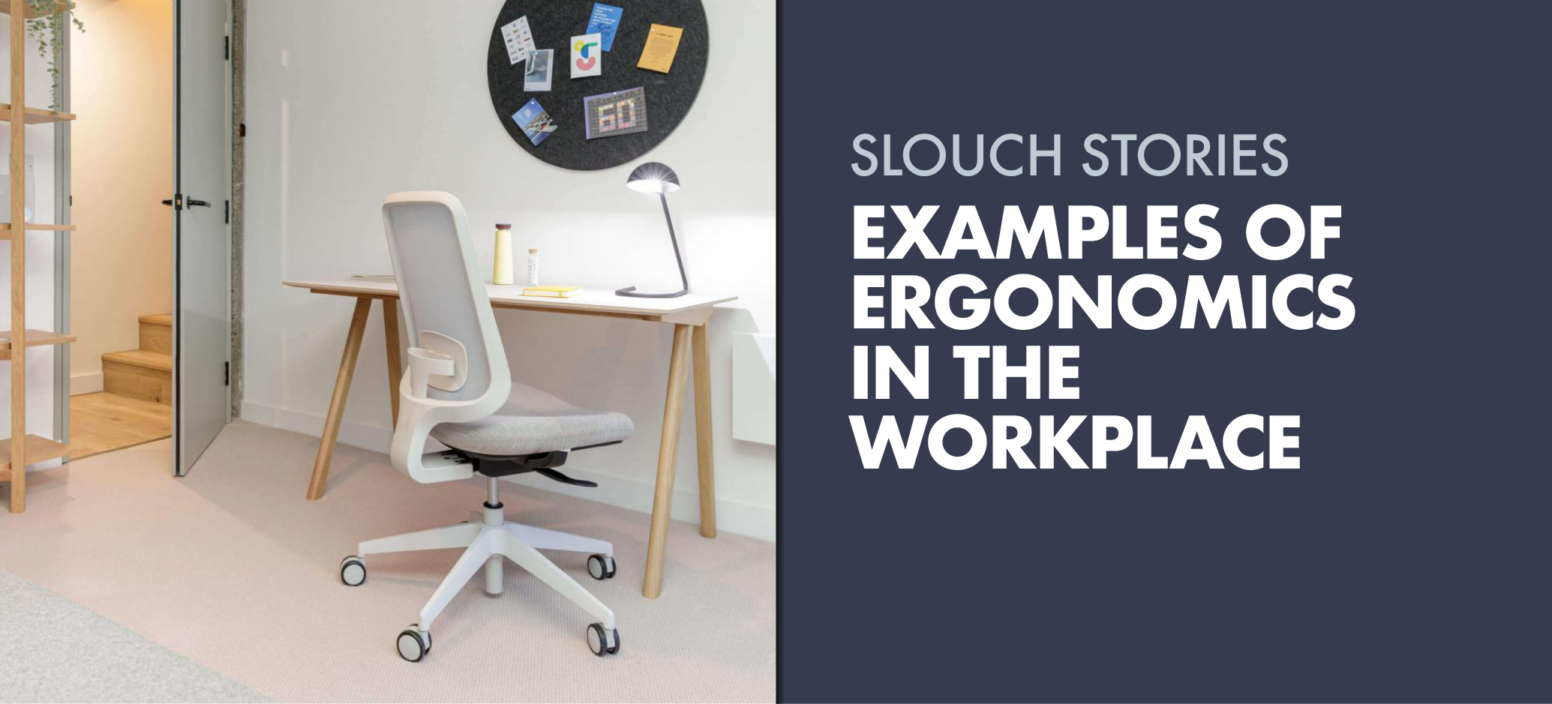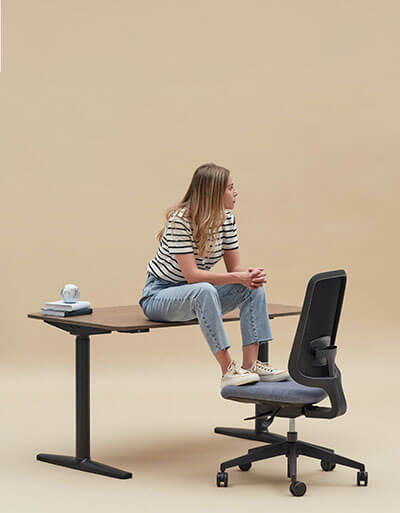In this blog we explore 7 examples of ergonomics in the workplace and their ability to facilitate your work, removing physical or mental barriers and leaving you less frustrated.
We often talk about how comfortable and supportive our Slouch home office furniture is: Backed by science, created by experts in engineering with a point to prove.
So in this blog, we’ll give you specific scenarios where ergonomics could play a part in your workplace. Products which may be able to tackle strains, aches or discomfort – working with you instead of against you. To help you on your way towards a day well spent and a job well done.
IMPORTANCE OF ERGONOMICS IN THE WORKPLACE
Ergonomics aims to remove barriers, roadblocks and difficulties in getting a task done at work, by creating a workspace and equipment which facilitates productivity instead of impeding it.
This involves allowing you to use an item without feeling any pain or discomfort, to make it accessible to you in spite of any present conditions or if you are differently abled.
Ergonomics aims to have a positive and notable impact on health and wellbeing in the workplace while improving your work pace, productivity and efficiency. It also strives to make you as a worker feel more valued, improving job satisfaction, as well as making people of different abilities feel included. In our blog about the Aims of Ergonomics, we discuss this in more detail.
7 EXAMPLES OF ERGONOMIC PRODUCTS IN THE WORKPLACE
If you’re not actively looking out for ergonomic principles at work, it might be easy to overlook. But in a workspace – ergonomic examples can be found everywhere:
1. CHAIRS WITH ADJUSTABLE HEIGHT
If your office chairs are at the wrong height for its users, this can cause discomfort and pain in the hips, legs, and lower back, causing aches or cutting off circulation.
As part of a desk, seat & equipment assessment (DSE) in the workplace, you’re encouraged to have a proper sitting posture and to set up your equipment in a manner that facilitates proper posture. This is an example of your chair being able to accommodate you ergonomically.
You should raise your chair high enough to allow the soles of your feet to rest flat on the floor. Thighs should be parallel to the floor at a right angle so that the hips are level with the knees. How easy this is to achieve if at all, varies with different types of office chairs.
At Slouch for example, our task chairs offer full swivel and height adjustment functionality, so tailoring your sitting experience should be a doddle.
This minimises pressures and strains and allows you to stay comfortable for longer – but remember to take regular breaks and stretch your legs!
Something else about chairs is – as we cover in our blog about lumbar support – how properly supporting the curvature of the spine prevents lower back pain.
2. DESKS WITH ADJUSTABLE HEIGHT
Number 2 on our list of ergonomics examples is your desk height.
If you’re full of energy and struggle to sit still for long, or if you experience restless legs, a standing desk allows you to work while standing rather than sitting down.
This can help with posture and circulation, as well as keeping your energy levels high without agitation or leaving you feeling restricted and tied to a desk all day.
Standing desks allow transitioning between sitting and standing for a best-of-both-worlds approach, allowing a variety of working positions throughout the day.
Our own Slouch office desks can facilitate this purpose, allowing you to sit or stand at your pleasure.
Whether you’re sitting or standing, to avoid wrist aches, pains and conditions like repetitive strain injury and carpal tunnel syndrome, users should maintain desks at a height that allows them to keep their forearms parallel to the floor and their wrists in a neutral position.
3. TURN RESTLESSNESS INTO EXERCISE WITH EXERCISE BALLS
Especially handy if you work from home – using an exercise ball as a seat can be a game-changer for promoting ergonomics and well-being – a way to stay active throughout the day, offering a dynamic seating option that engages your core muscles.
If you tend to feel restless and sluggish as the workday progresses, this could transform your working experience, providing an opportunity for regular movement and stretching throughout the day, promoting spinal alignment, reducing the risk of musculoskeletal issues, and enhancing your overall comfort.
4. MONITOR TILE AND PLACEMENT
DSE guidance advises that the position of the computer monitor should be so that the top of the screen is at or slightly below eye level.
In doing this, the neck and head should be in the optimal position to help reduce neck and eye strain. Making your screen easier to see without discomfort is one of many examples of ergonomics at play in your work environment.
Nothing can make a work day longer and less productive than a rocketing headache and prevention is better than cure after all. Investing in one of our desk monitor stands will help you to find the ideal monitor height for your workspace.
5. KEYBOARD AND MOUSE PLACEMENT
Place the keyboard and mouse in a position that allows elbows to be at a 90-degree angle and wrists to be straight. Avoid placing these items too far away, which can cause overreaching and shoulder strain.
Additionally, if these objects are too close, this could mean you’re in a cramped space, indicating your desk is too small and requires a larger workspace to accommodate you and your equipment. Being too confined in this way can slow down your keyboard work, causing excess pressure at the wrists causing aches and fatigue.
6. LIGHTING THAT ISN’T HARSH ON THE EYES
Another example of ergonomics in the workplace. And quite a big one too.
The barely perceptible flicker of fluorescent office lights sends chaotic signals to your brain. If you’re susceptible to this flicker, these signals can speed up fatigue and can trigger headaches or even migraine attacks. Do you do your best work while suffering from crippling headaches and migraines?
Thought not.
So the ergonomic solution to fluorescent overhead lights is a lighting alternative that can accommodate different people’s sensitivities.
This could be in the form of adjustable lighting, desk lamps and floor lamps to reduce glare and prevent eye strain and discomfort. Avoid positioning a screen in front of a bright light source too.
7. A HEADSET FOR HANDS-FREE COMMUNICATION
While pretty commonplace for jobs where you’re using the phone regularly, forgoing the traditional physical phone and using a headset and remote/automatic dialler has ergonomics and well-being in mind.
If you’re making one or two calls a day the manual dial may be a preference, but if you’re having hundreds of phone conversations a day, picking up the phone, dialling a number and holding the phone to your ear while also handling a multitude of other tasks would definitely be a roadblock to your productivity.
Hands-free communication enables you to multitask without compromising posture and minimises the strain on the neck and shoulders associated with cradling a phone between the ear and shoulder for extended periods.
ERGONOMIC OFFICE FURNITURE THAT MAKES YOUR WORKING DAY SHORTER AT SLOUCH
Looking for a new office desk for your home? Hoping to get the wheels turning on your brand new Slouch office chair? Or bulk ordering several task chairs for your workplace? If you have any enquiries, about design or assembly for example, you can reach us at [email protected] and our experts will be in touch to assist.
Seize a winning combo with a home office task chair and matching Slouch work desk designed with you in mind and fill out this contact form today.

